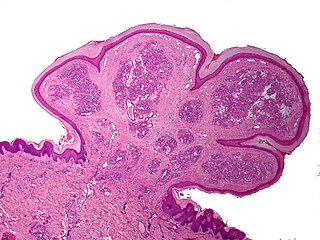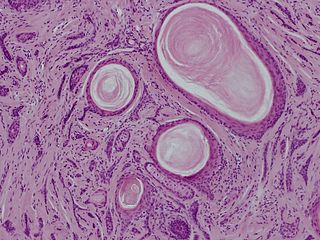
Alopecia areata, also known as spot baldness, is a condition in which hair is lost from some or all areas of the body. It often results in a few bald spots on the scalp, each about the size of a coin. Psychological stress and illness are possible factors in bringing on alopecia areata in individuals at risk, but in most cases there is no obvious trigger. People are generally otherwise healthy. In a few cases, all the hair on the scalp is lost, or all body hair is lost. Hair loss can be permanent, or temporary.

Calcinosis cutis is an uncommon condition marked by calcium buildup in the skin and subcutaneous tissues. Calcinosis cutis can range in intensity from little nodules in one area of the body to huge, crippling lesions affecting a vast portion of the body. Five kinds of the condition are typically distinguished: calciphylaxis, idiopathic calcification, iatrogenic calcification, dystrophic calcification, and metastatic calcification.

A pyogenic granuloma or lobular capillary hemangioma is a vascular tumor that occurs on both mucosa and skin, and appears as an overgrowth of tissue due to irritation, physical trauma, or hormonal factors. It is often found to involve the gums, skin, or nasal septum, and has also been found far from the head, such as in the thigh.

Pili torti is characterized by short and brittle hairs that appear flattened and twisted when viewed through a microscope.
Palisaded neutrophilic and granulomatous dermatitis (PNGS) is usually associated with a well-defined connective tissue disease, lupus erythematosus or rheumatoid arthritis most commonly, and often presents with eroded or ulcerated symmetrically distributed umbilicated papules or nodules on the elbows.

Acrokeratoelastoidosis of Costa or Acrokeratoelastoidosis is a hereditary form of marginal keratoderma, and can be defined as a palmoplantar keratoderma. It is distinguished by tiny, firm pearly or warty papules on the sides of the hands and, occasionally, the feet. It is less common than the hereditary type of marginal keratoderma, keratoelastoidosis marginalis.

A connective tissue nevus is a skin lesion which may be present at birth or appear within the first few years of life. It is elevated, soft to firm in consistency, varying in size from 0.5 to several centimeters in diameter, and may manifest as grouped, linear, or irregularly-distributed lesions.
Multifocal lymphangioendotheliomatosis, also known as congenital cutaneovisceral angiomatosis with thrombocytopenia and multifocal lymphangioendotheliomatosis with thrombocytopenia (MLT), is a skin condition that presents at birth with hundreds of red-brown plaques as large as several centimeters.
Onychophosis is a localized or diffuse hyperkeratotic tissue that develops on the lateral or proximal nailfolds, within the space between the nailfolds and the nail plate, and is a common finding in the elderly. Onychophosis may involve the subungual area, as a direct result of repeated minor trauma, and most frequently affects the first and fifth toe.
Melanonychia is a black or brown pigmentation of a nail, and may be present as a normal finding on many digits in Afro-Caribbeans, as a result of trauma, systemic disease, or medications, or as a postinflammatory event from such localized events as lichen planus or fixed drug eruption.
Pterygium inversum unguis or ventral pterygium is characterized by the adherence of the distal portion of the nailbed to the ventral surface of the nail plate. The condition may be present at birth or acquired, and may cause pain with manipulation of small objects, typing, and close manicuring of the nail. secondary due to connective tissue disorders. Pterygium inversum unguis is often asymptomatic.
Pigmented hairy epidermal nevus syndrome, also known as Becker's naevus syndrome, is a cutaneous condition characterized by a Becker nevus, ipsilateral hypoplasia of the breast, and skeletal defects such as scoliosis.
Self-healing juvenile cutaneous mucinosis is a skin condition caused by fibroblasts producing abnormally large amounts of mucopolysaccharides, and is characterized by the sudden onset of skin lesions and polyarthritis.
Onychomatricoma is a cutaneous condition characterized by a distinctive tumor of the nail matrix.

Generalized granuloma annulare is a skin condition of unknown cause, tending to affect women in the fifth and sixth decades, presenting as a diffuse but symmetrical, papular or annular eruption of more than ten skin lesions, and often hundreds.

Desmoplastic trichoepithelioma is a cutaneous condition characterized by a solitary, firm skin lesion on the face. Familial cases have been reported suggesting a possible genetic link.
Rheumatoid neutrophilic dermatitis, also known as rheumatoid neutrophilic dermatosis, is a cutaneous condition associated with rheumatoid arthritis.
Congenital erosive and vesicular dermatosis is a cutaneous condition characterized by generalized erosions, vesicles, crusting and ‘scalded skin-like’ erythematous areas affecting up to 75% of the body surface area.
Short anagen syndrome is a condition where hair does not grow beyond a short length, due to an unusually short duration of active hair growth. Most cases are associated with fine blond hair.
Mark G. Lebwohl is an American dermatologist and author who is Professor and Chairman Emeritus of the Kimberly and Eric J. Waldman Department of Dermatology and the Dean for Clinical Therapeutics at the Icahn School of Medicine at Mount Sinai in New York City.







